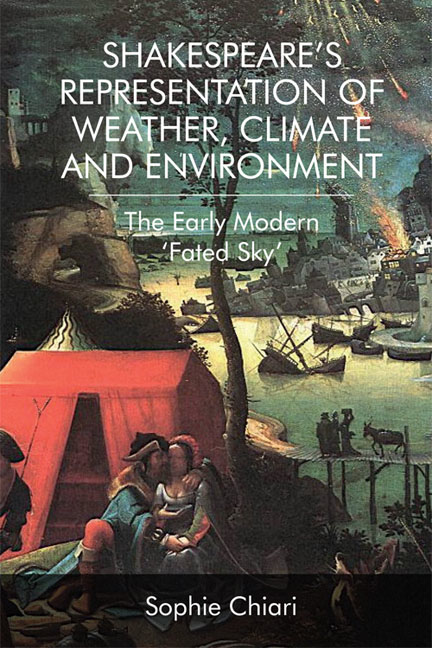Book contents
- Frontmatter
- Contents
- Illustrations
- Acknowledgements
- Textual Note
- Introduction
- 1 ‘We see / The seasons alter’: Climate Change in A Midsummer Night's Dream
- 2 ‘[T]he fire is grown too hot!’: Romeo and Juliet and the Dog Days
- 3 ‘Winter and rough weather’: Arden's Sterile Climate
- 4 Othello: Shakespeare's À bout de souffle
- 5 ‘The pelting of [a] pitiless storm’: Thunder and Lightning in King Lear
- 6 Clime and Slime in Anthony and Cleopatra
- 7 The I/Eye of the Storm: Prospero's Tempest
- Conclusion: ‘Under heaven's eye’
- Bibliography
- Index
4 - Othello: Shakespeare's À bout de souffle
- Frontmatter
- Contents
- Illustrations
- Acknowledgements
- Textual Note
- Introduction
- 1 ‘We see / The seasons alter’: Climate Change in A Midsummer Night's Dream
- 2 ‘[T]he fire is grown too hot!’: Romeo and Juliet and the Dog Days
- 3 ‘Winter and rough weather’: Arden's Sterile Climate
- 4 Othello: Shakespeare's À bout de souffle
- 5 ‘The pelting of [a] pitiless storm’: Thunder and Lightning in King Lear
- 6 Clime and Slime in Anthony and Cleopatra
- 7 The I/Eye of the Storm: Prospero's Tempest
- Conclusion: ‘Under heaven's eye’
- Bibliography
- Index
Summary
May the winds blow till they have wakened death (2.1.187)
The psychological and spiritual experience of climate in the not-sogreen world of the forest of Arden gives way to an elemental and humoral one in the vaster blue world of Othello. In a 1601 treatise on passions, the Roman Catholic priest and religious controversialist Thomas Wright (c. 1561–1623), a member of the Essex circle for a brief period of time, describes human emotions in terms of maritime and weather images which are indicative of how climate, humours and the elements combined in the English popular imagination at the turn of the century: ‘we may compare the Soul without Passions to a calm Sea; with sweet, pleasant, and crispling streams; but the Passionate, to the raging Gulf swelling with waves, surging by tempests, menacing the stony rocks, and endeavouring to overthrow Mountains’, after which he concludes that ‘even so Passions make the Soul to swell with pride and pleasure; they threaten wounds, death and destruction by audacious boldness and ire […] and, in sum, never let the Soul be in quietness, but ever either fl owing with Pleasure or ebbing with Pain’. In 1596, Wright had warned Essex's secretary, Anthony Bacon, against a possible Spanish invasion, which may explain why his prose imagery here contains possible reminiscences of the battle of the English fleet against the Spanish Armada.
Composed only a few years after the publication of this treatise, Shakespeare's Othello also depicts the travails of a passionate soul in a world of elemental passions, full of swelling water and battering winds. Probably written around 1603–4, the play is based on a number of myths, legends and popular romances that perfectly fit the genre of the love tragedy which Shakespeare initiated with Romeo and Juliet. Yet it can also lend itself to a symbolic, climatic interpretation. It shows how spring (which began on Valentine's Day in popular calendars), the season of love when the carnivalesque winds of February announce the erotic breezes of Venus, is ruined by the premature advent of autumn under Saturn's influence. This calendrical and astrological scheme is brought to the fore thanks to an overall cosmological pattern that lays bare the links between human emotions and the natural environment.
- Type
- Chapter
- Information
- Shakespeare's Representation of Weather, Climate and EnvironmentThe Early Modern ‘Fated Sky’, pp. 111 - 149Publisher: Edinburgh University PressPrint publication year: 2017

